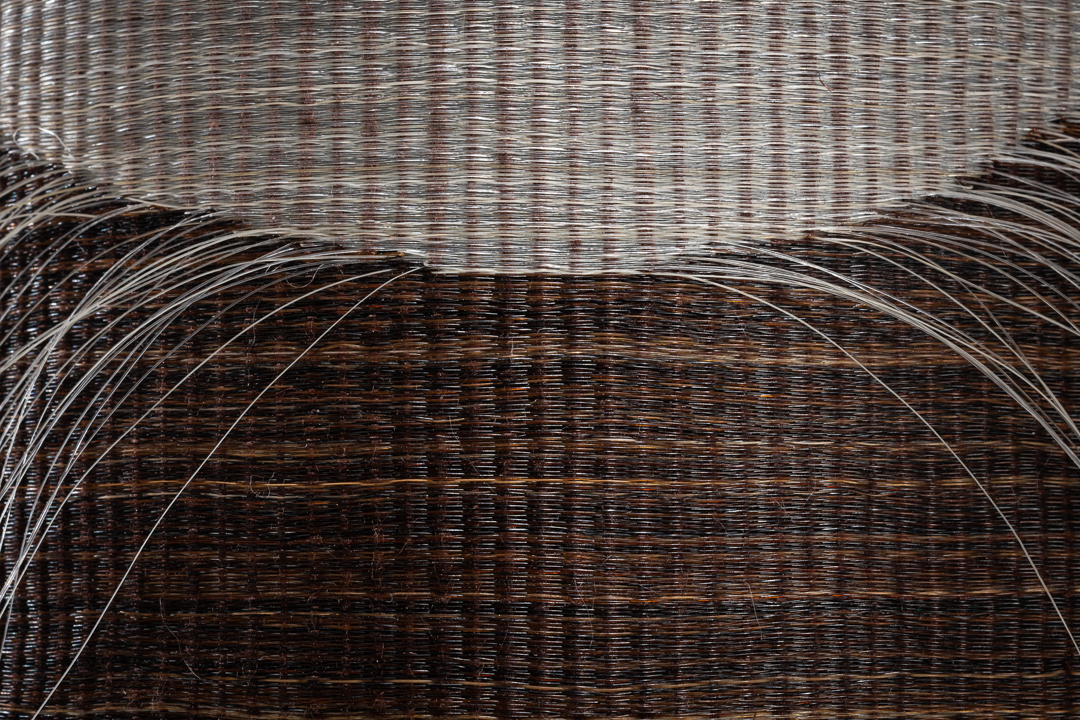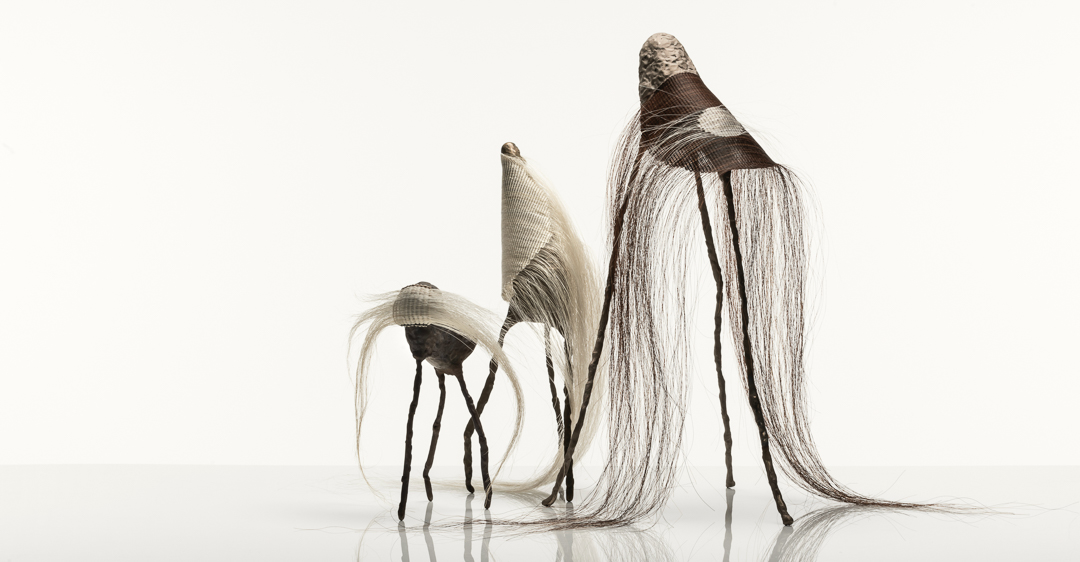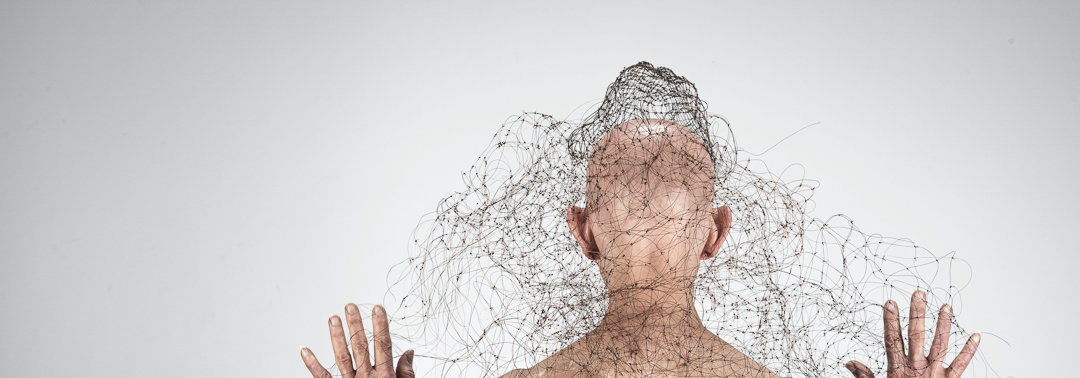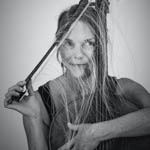
Jane Théau, The Soul of a Unicorn (detail), 2019, bronze and horsehair 163 x 80 x 100 cm. Photo Greg Piper
Jane Théau’s work reflects the primordial role of tactility in the way we think and feel.
The sensory memories generated in the process of making are embedded in us and in the objects we create. For a woodworker, it’s the smell of shavings, the sound of the plane peeling into the wood and the sight and feel of the grain lines. Foundry workers smell the molten bronze and sense its heat, and they feel the impact of the chisel during the chasing process. A weaver smells the odour of wool, the clack of the loom, the feel of the taut warp threads and their gradual disappearance as the weft grows. These experiences stay with craftspeople long after they finish their work. Perhaps the most potent sensory memory derives from the sense of touch.
A few years ago, on an artist’s residency at Textilsetur in Iceland, I took up weaving and the first fibre I wove was horsehair. It was a stray hair from my cello bow that left me intrigued by the unique material properties of this fibre: it is not supple and matt, like thread, nor stiff and bright like wire. When woven it shines and is smooth and strong. When long, it caresses, evoking sensuality, and when short, it bristles and creates discomfort (the expression “hair shirt” conjures guilt and penitence). It is time-consuming weaving with horsehair because, being of finite length, it cannot be wound onto a shuttle. Each hair must be passed through the warp individually. This fact makes it an extremely tactile process. As I wove horsehair in that Arctic attic, I was impelled at the end of every row to run my hands through the fringe of hair I had left hanging at the selvedge. The hair seemed to talk to my skin.
Weight, temperature, volume, and texture can only be properly perceived by our tactile sense. The British sculptor Barbara Hepworth considered these characteristics vital to a complete understanding of sculpture which she believed “is perceived, above all, by the sense of touch.” Despite the importance of touch, within the hierarchy of the senses it has long been neglected in Western culture, particularly in art. To perceive an art object holistically requires all the senses, and yet in galleries and museums, we are permitted to engage only by looking.
…there is a term in the textile industry called the “hand” which describes the feel of fabric against one’s skin
Touch is particularly vital to appreciating art made with textiles. Of all the materials in the world, the organ of touch (skin) is most familiar with fabric. This constant proximity of textiles to skin gives them, as an art medium, an uncommon sensory power. The textile academic Jessica Hemmings begins her anthology, The Textile Reader, thus: “Anyone who loves textiles touches them.” So implicated are touch and fabric that there is a term in the textile industry called the “hand” which describes the feel of fabric against one’s skin. I believe this tactility is responsible for the explosion of art made with textiles, and that it is no coincidence this has occurred in tandem with the rise of the internet and the time we spend online instead of doing things in person, with our bodies. There may be no correlation between textiles in museums and digital disembodiment, but the conflation is compelling. My doctoral research investigated this hypothesis.
I explored the relationship between touch and textiles through the lens of the book The Five Senses, written by the philosopher Michel Serres. In this book he asks that we reassess the Western focus on vision as the most important of the senses and he leads with touch, the sense that situates us in the world. The only reason we are conscious is because touch mediates our relationship with the realm that swirls outside our fleshy envelope. Touch facilitates proprioception (the ability to locate oneself in space) and kinaesthesia (how we perceive the movement of the body). It creates embodied memories, contributes to the formation of knowledge and is vital to our emotional well-being. We can carry on without sight or hearing or taste or smell, but it is impossible to exist without touch. We are because we feel. The essential nature of the sense of touch to our knowledge of ourselves led Serres to suggest that our soul is in our skin, a proposition I’m sure many craftspeople would consider has some merit!
Drawing upon a previous career in neurobiology research I did some initial reading to understand how our sense of touch works, particularly how skin seems to hold its own memories. The scientist Mitsuhiro Denda described skin as our “third brain”. This is because a proportion of the sensory information our body receives is actually processed in the cells of the skin before being conveyed to the brain. This explains why I can still feel in my fingers the wool of the first jumper I knitted, and in the skin under my thighs, the wooden chair from kindergarten, and my fringe falling across my four-year-old forehead. Neurons are embedded in the layers of the skin to sense humidity, pressure, temperature, position in space and movement. Some of these encircle our hair follicles, like copper wire around an electromagnet, and this fact firmly implicates hair in the making of tactile memories. I wanted to create a body of work that would actively entice people to touch it, what better fibre to work with than hair to elicit that desire? The objects most frequently felt against skin are hair and textiles – and so I created textiles made from hair.
Making
My doctoral body of work included horsehair woven into textiles that adorned bronze sculptures (the Soul series), horsehair knotted into nets (For Catching a Soul) and horsehair threaded through felt and worn in a dance performance (Touching Joy). Making each of the works was a performance of the senses, as is all making. In the process of weaving, I would accidentally pluck the warp threads which engaged the sense of hearing as well as touch. (There is an interesting relationship between the loom and the development of stringed instruments.) I chose to pair the woven horsehair with bronze sculptures, deliberately contrasting the massy, cold, solid nature of bronze with the light, relatively warm and loose nature of the fabric.

Jane Theau, A Little Gentle Soul, The Soul of a Little Unicorn, A Gentle Soul, 2019 – 2020, bronze and horsehair (tallest 52cm). Photo Greg Piper
While knotting horsehair into nets for Untouchable Soul I felt the dichotomous touch of the strands – smooth one way and resistant the other – sensations caused by the scaled structure of a hair as viewed under a microscope. And as I threaded the horsehair through thick woollen felt to create a hairy coat to be worn by my cello and my dance collaborator in the performance Touching Joy, I smelt a trace of lanolin still in the wool and felt the hard needle slide smoothly through the matted, fuzzy fabric. Inside the felt/hair coat were hundreds of horsehair knots that prickled the skin uncomfortably while at the same time the long strands that flowed from the exterior swished softly: the wearer felt simultaneously the bristle and caress of this one unique fibre.
The opportunities for tactile engagement in everyday life have diminished with the march of modernity. I have tried to put some of these opportunities back by allowing people to touch my work. Through touch they can explore how the works are made and the materials with which they are created so they can understand the work more fully through embodied experience. This was standard practice in museums of the 19th century that were filled with accessible cabinets of curiosities. While this leaves my work open to being damaged, it has been my experience that in a museum setting people are usually respectful and touch tentatively (if at all) even when given permission.

Jane Theau, Untouchable Soul, (dimensions variable), copper electro-plated horsehair, horsehair and cotton, worn by dancer Anca Frankenhaeuser. Photo Greg Piper
How important is the sense of touch and the other non-visual senses to our relationship with art, and indeed to the world at large? How important should it be? Is this tactile disconnect playing out in our increasingly distant relationship with nature? The final year of my research was conducted in the thick of the COVID pandemic, a time when touch fell completely out of favour. All of a sudden, it was not just art that could not be touched, touching anything was called into question. We were forced to rely on digital technology to stay connected precisely because it did not involve physical contact, and this reliance highlighted for me how important touch is, not only to our appreciation of art, but to every aspect of our lives. It is frequently said that the purpose of art is to elevate the soul. If our soul is in our skin, as Serres suggests, then touching art would truly help us achieve this goal. And touching art made with textiles, that most tactilely familiar of materials? Well, that could make our souls soar.
References
Candlin, F. (2010). Art, museums and touch. Manchester, Manchester University Press.
Denda, M. (2015). “Epidermis as the “Third Brain”?” Dermatologica Sinica 33(2): 70-73.
Denda, M., Nakatani, Masashi, Ikeyama, Kazuyuki, Tsutsumi, Moe & Denda, Sumiko (2007). “Epidermal keratinocytes as the forefront of the sensory system.” Experimental Dermatology 16(3): 157-161.
Hemmings, J. (2012). The Textile Reader. London, Berg Publishers.
Hepworth, B. “Quotations from Barbara Hepworth’s Writings.”
About Jane Théau
 I am an artist, community art facilitator, curator and President/founder of Textiles Sydney. My practice is multi-disciplinary, encompassing sculpture, installation and performance. I previously worked in scientific research and economic development, disciplines that continually influence my work as an artist. Follow @janetheau.
I am an artist, community art facilitator, curator and President/founder of Textiles Sydney. My practice is multi-disciplinary, encompassing sculpture, installation and performance. I previously worked in scientific research and economic development, disciplines that continually influence my work as an artist. Follow @janetheau.



Comments
Wonderful work! You have described the poetics of the pieces beautifully.